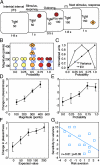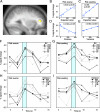Reward value coding distinct from risk attitude-related uncertainty coding in human reward systems
- PMID: 17122317
- PMCID: PMC2637604
- DOI: 10.1152/jn.00745.2006
Reward value coding distinct from risk attitude-related uncertainty coding in human reward systems
Abstract
When deciding between different options, individuals are guided by the expected (mean) value of the different outcomes and by the associated degrees of uncertainty. We used functional magnetic resonance imaging to identify brain activations coding the key decision parameters of expected value (magnitude and probability) separately from uncertainty (statistical variance) of monetary rewards. Participants discriminated behaviorally between stimuli associated with different expected values and uncertainty. Stimuli associated with higher expected values elicited monotonically increasing activations in distinct regions of the striatum, irrespective of different combinations of magnitude and probability. Stimuli associated with higher uncertainty (variance) elicited increasing activations in the lateral orbitofrontal cortex. Uncertainty-related activations covaried with individual risk aversion in lateral orbitofrontal regions and risk-seeking in more medial areas. Furthermore, activations in expected value-coding regions in prefrontal cortex covaried differentially with uncertainty depending on risk attitudes of individual participants, suggesting that separate prefrontal regions are involved in risk aversion and seeking. These data demonstrate the distinct coding in key reward structures of the two basic and crucial decision parameters, expected value, and uncertainty.
Figures









References
-
- Aron AR, Shohamy D, Clark J, Myers C, Gluck MA, Poldrack RA. Human midbrain sensitivity to cognitive feedback and uncertainty during classification learning. J Neurophysiol 92: 1144–1152, 2004. - PubMed
-
- Bechara A, Damasio H, Damasio AR. Emotion, decision-making and the orbitofrontal cortex. Cereb Cortex 10: 295–307, 2000. - PubMed
-
- Bechara A, Damasio AR, Damasio H, Anderson SW. Insensitivity to future consequences following damage to human prefrontal cortex. Cognition 50: 7–15, 1994. - PubMed
-
- Bernoulli D Exposition of a new theory on the measurement of risk (translated from Latin). Econometrica 22: 23–36, 1954.
-
- Bolla KI, Eldreth DA, Matochik JA, Cadet JL. Neural substrates of faulty decision-making in abstinent marijuana users. Neuroimage 26: 480–492, 2005. - PubMed
Publication types
MeSH terms
Substances
Grants and funding
LinkOut - more resources
Full Text Sources
Medical

